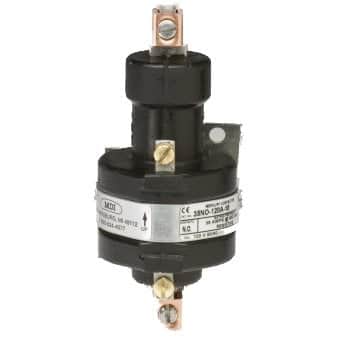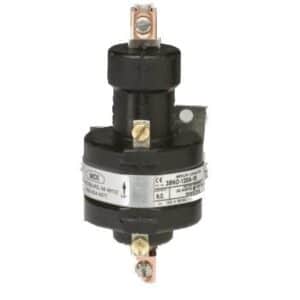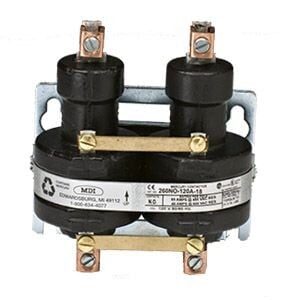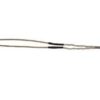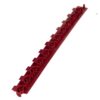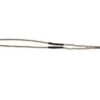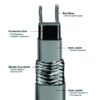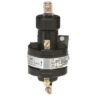Description
35 Amp 1 Pole, 120VAC holding coil mercury displacement relay
Mercury Displacement Relays are all designed and built to meet the most exacting demands of industry. They have won their high place in the electrical field by doing the tough and tricky jobs that ordinary equipment could at best do in an uncertain manner. They have proved their ability to stand up under the most adverse conditions of temperature, dust and moisture, in all types of applications. All the care required for the manufacture of high-grade instruments is used in the manufacture of the switches. All switch parts are specially cleaned, and contamination is avoided by use of tweezers, gloves, etc., when making assemblies.
35/60-AMP Normally Open Contactors Typical Specifications:
- Operate Time: 50 milliseconds
- Release Time: 80 milliseconds
- Contact Resistance:
- 35-AMP = .003 ohm *
- 60-AMP = .002 ohm*
- Dielectric Withstand: 2500 Vac Rms
- Longevity: Millions of Cycles
- Temperature Range: -35 degrees C to 85 degrees C
- Coil Terminals: #6 Binding Head Screws
- Load Terminals: Pressure Connectors for A.W.G. #4 - #14 on 35-AMP Units and A.W.G. #2 - #8 on 60-AMP Units
- UL Listing: File #E62767 for 35 and 60-AMP N.O. Units 1-4 Poles
- C.S.A.: File #LR41198 for 35 and 60-AMP N.O. Units (Heater Loads) 1-3 Poles
- Auxiliary Devices for Use in Hazardous Locations. UL File #E71867 N.O. Units Approved for Class 1, Groups A, B, C and D, Division 2 Only. To Order for Hazardous Locations, Add the Suffix -X to Part Number.
* After Cycling Under Load
MERCURY TO METAL CONTACTOR:
The load terminals are isolated from each other by the glass in the hermetic seal. "The plunger assembly", which includes the ceramic insulator, the magnetic sleeve and related parts, floats on the mercury pool. When the coil is powered causing a magnetic field, the plunger assembly is pulled down into the mercury pool which is in turn displaced and moved up to make contact with the electrode, closing the circuit between the top and bottom load terminal, which is connected to the stainless steel can.
Proper Fusing is Required
While MDIs contactors handle high inrush, such as lamp loads, very well, mercury contactors are susceptible to damage by short circuit currents, and should be fused to minimize short circuit fault currents. Fast acting UL class RK-1 and class J fuses and semiconductor I2t fuses more effectively protect relays than other fuses. These are low-peak fuses designed to limit short circuit currents. Regardless, when there is a short circuit, relay operations should be closely monitored afterward because of the possibility of concealed damage that could cause the relays to behave inconsistently.
| Amps | Amps | Amps | Amps | ||
| Type of Loads | Voltage | 35NO | 35NO(H) | 60NO | 60NO(H) |
| A.C. Resistive | 240V | 35 | 35 | 60 | 60 |
| 480V | 35 | 35 | 60 | 60 | |
| 600V | 35 | 48 | |||
| A.C. Inductive P.F .4 or greater | 120V | 25 | 30 | ||
| 240V | 15 | 20 | |||
| General Purpose P.F. .7 or greater | 240V | 60 | |||
| 480V | 60 | ||||
| D.C Resistive heating | 48V | 35 | 60 | ||
| 125V | 16 | 40 | |||
| 250V | 12 | 20 | |||
| Tungsten lamp | 120V | 35 | 35 | 60 | 60 |
| Single phase motor loads | 120V | 1HP | 2HP | 3HP | |
| 240V | 1HP | 3HP | 3HP | ||
| Three phase motor loads | 240V | 5HP | 7.5HP | ||
| 480V | 7.5HP | 10HP |


















